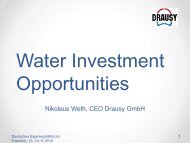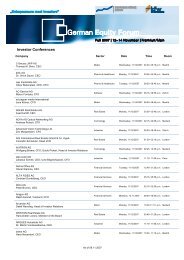Conference Magazine - GoingPublic.de - Deutsches Eigenkapitalforum
Conference Magazine - GoingPublic.de - Deutsches Eigenkapitalforum
Conference Magazine - GoingPublic.de - Deutsches Eigenkapitalforum
You also want an ePaper? Increase the reach of your titles
YUMPU automatically turns print PDFs into web optimized ePapers that Google loves.
Corporate Financing<br />
What are credit ratings?<br />
Ratings reduce information asymmetry and improve<br />
market functioning and efficiency<br />
Credit ratings are opinions about credit risk. Standard &<br />
Poor’s ratings express the agency’s opinion on the ability<br />
and willingness of an issuer, such as a corporation, to meet<br />
its financial obligations in full and on time. Credit ratings<br />
can also allow individuals to get a picture of the credit<br />
quality of an individual <strong>de</strong>bt issue, such as a corporate<br />
bond, and the relative likelihood that the issue may <strong>de</strong>fault.<br />
We express our ratings as letter gra<strong>de</strong>s ranging from ‘AAA’<br />
to ‘D’ to communicate our opinion on the relative level of<br />
credit risk.<br />
We base our ratings on analyses performed by experienced<br />
credit analysts who evaluate and interpret information<br />
received from issuers and other available sources to form a<br />
consi<strong>de</strong>red opinion. Unlike other types of opinions, such<br />
as, for example, those provi<strong>de</strong>d by doctors or lawyers,<br />
credit ratings opinions are not inten<strong>de</strong>d to be a prognosis or<br />
recommendation. Ratings should not be viewed as an<br />
assurance of credit quality nor as an exact measure of the<br />
likelihood of <strong>de</strong>fault. Rather, they are primarily inten<strong>de</strong>d to<br />
Figure 1: Standard & Poor’s analyst-driven rating process<br />
Source: Standard & Poor’s<br />
Page 16 <strong>Deutsches</strong> <strong>Eigenkapitalforum</strong> 2012<br />
Tobias Mock is a Managing Director<br />
and Lead Analytical Manager in the<br />
Corporate Ratings <strong>de</strong>partment of<br />
Standard & Poor’s, based in Frankfurt.<br />
He leads the Light Industries team in<br />
EMEA, which covers the telecoms,<br />
high-tech, media, retail, leisure, consumer<br />
goods, healthcare and real<br />
estate industries.<br />
Tobias Mock, Managing Director and<br />
Lead Analytical Manager, Corporate Ratings,<br />
Light Industries, Standard & Poor’s<br />
provi<strong>de</strong> investors and market participants with information<br />
about the relative credit risk of issuers and individual <strong>de</strong>bt<br />
issues that the agency rates.<br />
The corporate rating process<br />
at S&P<br />
When rating a corporation, we<br />
assign a lead analyst, often in conjunction<br />
with a team of specialists,<br />
to evaluate the entity’s credit -<br />
worthiness. Typically, analysts<br />
obtain information from published<br />
reports, interviews and discussions<br />
with the company’s management<br />
team, as well as from their sector<br />
and market analyses. The rating<br />
process is dynamic and evaluates<br />
qualitative and quantitative information<br />
on an ongoing basis. There<br />
is at least a bi-annual review for all<br />
corporate ratings and typically an<br />
annual meeting atten<strong>de</strong>d by the<br />
analytical team and the senior<br />
management team of the rated corporate.<br />
Fig. 1 illustrates the typical<br />
rating process for a corporation.
















